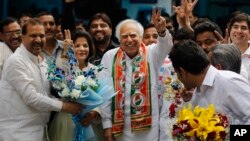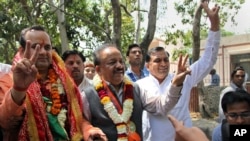NEW DELHI —
India's election spending is set to reach $5 billion as candidates spend millions of dollars on what studies say will be the country’s most expensive campaign. Analysts say a large portion of funding comes from unaccountable sources, and some is used to bribe voters.
This campaign season is a financial boon for many businesses -- particularly advertisers, helicopter and car lease companies, and those printing campaign posters and flags.
Although the ruling Congress Party and the opposition Bharatiya Janata Party are the main contenders, there are some 30 parties competing for the 543 seats in parliament. The election, which begins on April 7, will be spread over five weeks.
A study by the Center for Media Studies in New Delhi estimates that election spending this year will total $5 billion -- three times higher than in 2009. This includes the spending on polling by the election commission and money spent by political parties and their candidates.
The sum is being compared to the $7 billion spent by parties, candidates and support groups during the 2012 presidential election in the United States.
However, virtually none of the businesses benefiting from India’s polling splurge are willing to go on record. The reason: much of the spending is done in cash from unaccounted sources.
India's election commission caps candidate campaign spending at $115,000. But N. Bhaskara Rao, head of the Center for Media Studies, says it is well known that candidates spend many times that sum.
“This is a staggering amount and this works out to be much higher than anyone has ever thought of," said Rao. "Most of it goes from builders, liquor lobbies, contractors business, corporates, what we call quid pro campaigning. That means you expect to benefit out of it once the party comes to power.”
Not all the spending is done on slick advertising campaigns and political rallies. Observers say at least part of the money is set aside to bribe voters.
The election commission, which is credited with cleaning up Indian elections to a considerable extent, admits that this remains a problem. For example, it says that in the run up to five state elections held last year, it seized more than $9 million worth of cash and liquor meant to influence voters.
Chief Election Commissioner V.S. Sampath says one of the biggest challenges is curtailing the influence of what he terms “money power.” He has said they will deploy observers and use other measures to curb it.
Officials however admit that preventing the payouts is not easy in a vast country with millions of villages. And candidates have found innovative ways to hand out the cash. There have been reports of money being delivered in envelopes along with newspapers.
Bhaskara Rao of the Center for Media Studies says bribery this year could be more prevalent in two key heartland states that together account for 120 parliamentary seats and where the performance of the two main parties will make a decisive impact on their fortunes at a national level.
“In some states, more than 50 percent of the voters are paid money by the candidates, what we call note for vote," said Rao. "In the 2014 election, in states like UP (Uttar Pradesh) and Bihar, this phenomenon is going to be higher than ever before. Earlier it was only in Andhra Pradesh, Karnataka, Tamil Nadu.”
Observers say the problem is accentuated in areas where candidates with criminal records compete. Anil Verma is head of the Association of Democratic Reforms, a civil society group working to clean up Indian elections. He says a scrutiny of candidates whose names have been announced by the Congress and the BJP so far, reveals that the problem persists despite widespread calls to eliminate such contenders.
“So if you take an average of just these two main parties, 30 percent, roughly one third of them have got criminal cases and 13 percent with serious criminal cases. There are so many prominent people, who had resigned, and who had been sacked and they are again being given tickets. This is certainly an area of concern.”
Political analysts say unaccounted spending in Indian elections remains a root cause of corruption, and there have been frequent calls for more transparent funding.
Still, there is a silver lining. Although much of the massive splurge will remain in what is known as India’s black economy, the campaign will give a temporary boost to the country at a time when it is experiencing an economic slowdown.
This campaign season is a financial boon for many businesses -- particularly advertisers, helicopter and car lease companies, and those printing campaign posters and flags.
Although the ruling Congress Party and the opposition Bharatiya Janata Party are the main contenders, there are some 30 parties competing for the 543 seats in parliament. The election, which begins on April 7, will be spread over five weeks.
A study by the Center for Media Studies in New Delhi estimates that election spending this year will total $5 billion -- three times higher than in 2009. This includes the spending on polling by the election commission and money spent by political parties and their candidates.
The sum is being compared to the $7 billion spent by parties, candidates and support groups during the 2012 presidential election in the United States.
However, virtually none of the businesses benefiting from India’s polling splurge are willing to go on record. The reason: much of the spending is done in cash from unaccounted sources.
India's election commission caps candidate campaign spending at $115,000. But N. Bhaskara Rao, head of the Center for Media Studies, says it is well known that candidates spend many times that sum.
“This is a staggering amount and this works out to be much higher than anyone has ever thought of," said Rao. "Most of it goes from builders, liquor lobbies, contractors business, corporates, what we call quid pro campaigning. That means you expect to benefit out of it once the party comes to power.”
Not all the spending is done on slick advertising campaigns and political rallies. Observers say at least part of the money is set aside to bribe voters.
The election commission, which is credited with cleaning up Indian elections to a considerable extent, admits that this remains a problem. For example, it says that in the run up to five state elections held last year, it seized more than $9 million worth of cash and liquor meant to influence voters.
Chief Election Commissioner V.S. Sampath says one of the biggest challenges is curtailing the influence of what he terms “money power.” He has said they will deploy observers and use other measures to curb it.
Officials however admit that preventing the payouts is not easy in a vast country with millions of villages. And candidates have found innovative ways to hand out the cash. There have been reports of money being delivered in envelopes along with newspapers.
Bhaskara Rao of the Center for Media Studies says bribery this year could be more prevalent in two key heartland states that together account for 120 parliamentary seats and where the performance of the two main parties will make a decisive impact on their fortunes at a national level.
“In some states, more than 50 percent of the voters are paid money by the candidates, what we call note for vote," said Rao. "In the 2014 election, in states like UP (Uttar Pradesh) and Bihar, this phenomenon is going to be higher than ever before. Earlier it was only in Andhra Pradesh, Karnataka, Tamil Nadu.”
Observers say the problem is accentuated in areas where candidates with criminal records compete. Anil Verma is head of the Association of Democratic Reforms, a civil society group working to clean up Indian elections. He says a scrutiny of candidates whose names have been announced by the Congress and the BJP so far, reveals that the problem persists despite widespread calls to eliminate such contenders.
“So if you take an average of just these two main parties, 30 percent, roughly one third of them have got criminal cases and 13 percent with serious criminal cases. There are so many prominent people, who had resigned, and who had been sacked and they are again being given tickets. This is certainly an area of concern.”
Political analysts say unaccounted spending in Indian elections remains a root cause of corruption, and there have been frequent calls for more transparent funding.
Still, there is a silver lining. Although much of the massive splurge will remain in what is known as India’s black economy, the campaign will give a temporary boost to the country at a time when it is experiencing an economic slowdown.










